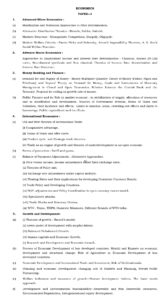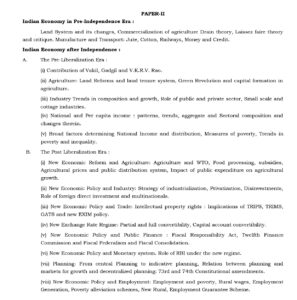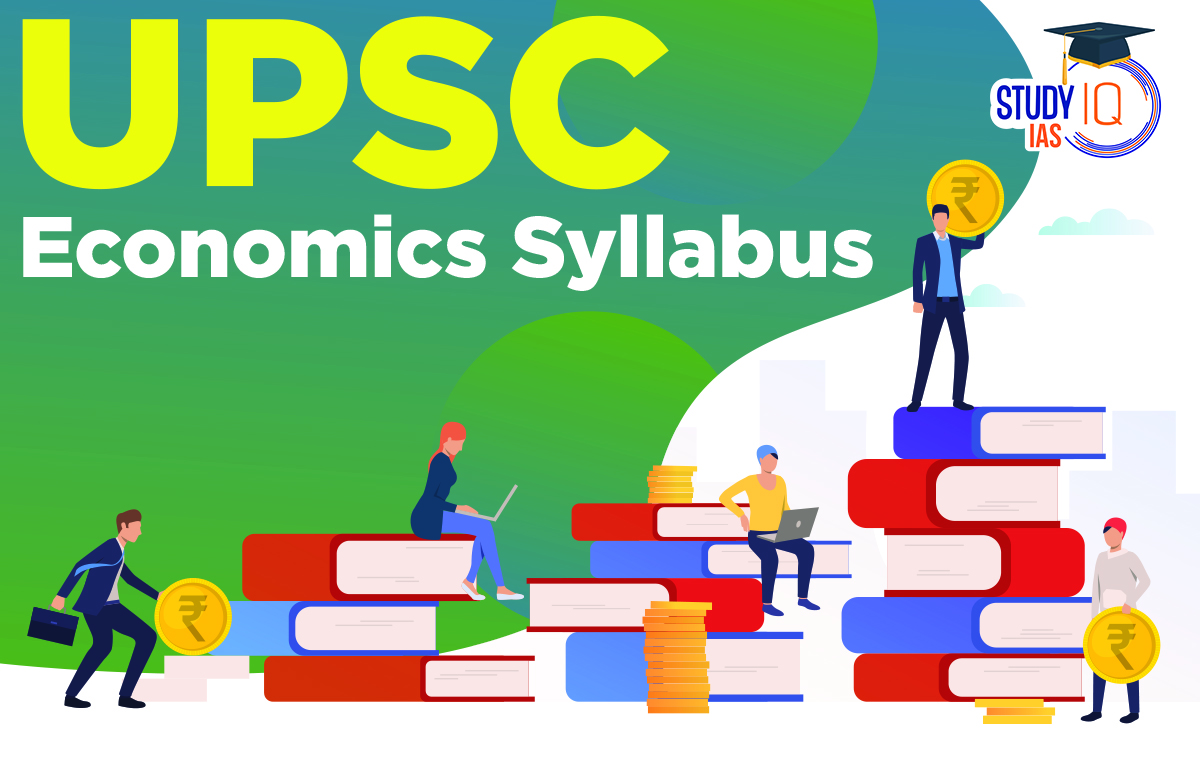Table of Contents
UPSC Economics Syllabus
The Economy is a required subject for both the IAS Prelims and the Mains of the UPSC civil services exam, as you are aware if you are preparing to take the exam. In the UPSC mains papers, it is also included as an optional subject. Candidates should have sufficient knowledge of the Indian Economy because economics questions in the Prelims exam are conceptual-based questions.
However, candidates who select Economics as an optional subject for the UPSC Mains exam must study the concepts in detail along with knowing the fundamentals of the Indian economy and Economic concepts. Candidates must be updated with the latest economic developments, trends, terminology, important factual data and national policies. If you opted to take economics as your optional subject and are preparing for the IAS Mains Exam, we have covered detailed topic-wise UPSC Economics Syllabus in the article below.
Economics Syllabus For UPSC Optionals
The candidates must be familiar with the UPSC Syllabus for the specific subjects as the first and most important stage in preparation for the UPSC CSE (Civil Service Examination). The UPSC Economics Syllabus for Optional Exam covers more than just the fundamental definitions; it also requires application-based knowledge of fundamental concepts, economic trends, and current financial and economic challenges, and also awareness of how to tackle the questions based on these topics.
Although economic NCERTs are essential for grasping the fundamentals they are not sufficient to comprehend the UPSC Economics Optional Syllabus. UPSC Economics Optional Syllabus is divided into two Papers and Each paper is assigned 250 marks, a total of 500 marks.
Read More: UPSC Optional Subjects
UPSC Economics Syllabus Paper 1
UPSC Economics Paper 1 will be 250 marks and this paper includes 5 units such as:
- Advanced Micro Economics
- Advance Macro Economics
- Money-Banking and Finance
- International Economics
- Growth and Development
The complete UPSC Economics Syllabus Paper 1 for each Unit are listed below:
1. Advanced Micro Economics:
(a) Marshallian and Walrasiam Approaches to Price determination.
(b) Alternative Distribution Theories: Ricardo, Kaldor, Kaleeki
(c) Markets Structure: Monopolistic Competition, Duopoly, Oligopoly.
(d) Modern Welfare Criteria: Pareto Hicks & Scitovsky, Arrow’s Impossibility Theorem, A.K. Sen’s Social Welfare Function.
2. Advanced Macro Economics: Approaches to Employment Income and Interest Rate determination: Classical, Keynes (IS-LM) curve, Neo classical synthesis and New classical, Theories of Interest Rate determination and Interest Rate Structure.
3. Money – Banking and Finance:(a) Demand for and Supply of Money: Money Multiplier Quantity Theory of Money (Fisher, Pique and Friedman) and Keyne’s Theory on Demand for Money, Goals and Instruments of Monetary Management in Closed and Open Economies. Relation between the Central Bank and the Treasury. Proposal for ceiling on growth rate of money. (b) Public Finance and its Role in Market Economy: In stabilization of supply, allocation of resources and in distribution and development. Sources of Govt. revenue, forms of Taxes and Subsidies, their incidence and effects. Limits to taxation, loans, crowding-out effects and limits to borrowings. Public Expenditure and its effects.
4. International Economics:
(a) Old and New Theories of International Trade
(i) Comparative Advantage
(ii) Terms of Trade and Offer Curve.
(iii)Product Cycle and Strategic Trade Theories.
(iv)Trade as an engine of growth and theories of underdevelopment in an open economy.
(b) Forms of Protection: Tariff and quota.
(c) Balance of Payments Adjustments: Alternative Approaches.
(i) Price versus income, income adjustments under fixed exchange rates,
(ii) Theories of Policy Mix
(iii)Exchange rate adjustments under capital mobility
(iv) Floating Rates and their Implications for Developing Countries: Currency Boards.
(v) Trade Policy and Developing Countries.
(vi) BOP, adjustments and Policy Coordination in open economy macro-model. (vii) Speculative attacks
(viii) Trade Blocks and Monetary Unions. (ix) WTO: TRIMS, TRIPS, Domestic Measures, Different Rounds of WTO talks.
5. Growth and Development:
(a) (i) Theories of growth: Harrod’s model,
(ii) Lewis model of development with surplus labour
(iii) Balanced and Unbalanced growth,
(iv) Human Capital and Economic Growth.
(v) Research and Development and Economic Growth
(b) Process of Economic Development of Less developed countries: Myrdal and Kuzments on economic development and structural change: Role of Agriculture in Economic Development of less developed countries.
(c) Economic development and International Trade and Investment, Role of Multinationals.
(d) Planning and Economic Development: the changing role of Markets and Planning, PrivatePublic Partnership
(e) Welfare indicators and measures of growth – Human Development Indices. The basic needs approach.
(f) Development and Environmental Sustainability – Renewable and Non-Renewable Resources, Environmental Degradation, Intergenerational equity development.
UPSC Economics Optional Syllabus Paper 1 PDF
UPSC Economics Paper 1 will be 250 marks and this paper includes 5 units such as:
- Advanced Micro Economics
- Advance Macro Economics
- Money-Banking and Finance
- International Economics
- Growth and Development
The complete UPSC Economics Syllabus Paper 1 for each Unit are listed below:

Read More: UPSC Geography Syllabus
UPSC Economics Syllabus Paper 2
UPSC Economics Paper 2 will be 250 marks and this paper is majorly classified into 2 units such as:
- Indian Economy in Pre-Independence Era
- Indian Economy After Independence
Paper 2 of Economics Optional majorly includes the Indian Economy scenario in Pre-independence time and after independence time. The candidates must prepare the concept and data of relevant topics to score good marks in the UPSC Optional section. The complete UPSC Economics Syllabus Paper 2 for each Unit are listed below:
Indian Economy in PreIndependence Era: Land System and its changes, Commercialization of agriculture, Drain theory, Laissez faire theory and critique. Manufacture and Transport: Jute, Cotton, Railways, Money and Credit.
2. Indian Economy after Independence:
A. The Pre-Liberalization Era:
- Contribution of Vakil, Gadgil and V.K.R.V. Rao.
- Agriculture: Land Reforms and land tenure system, Green Revolution and capital formation in agriculture,
- Industry Trends in composition and growth, Role of the public and private sector, Small scale and cottage industries.
- National and Per capita income: patterns, trends, aggregate and Sectoral composition and changes therein.
- Broad factors determining National Income and distribution, Measures of poverty, Trends in poverty and inequality.
B. The Post-Liberalization Era:
- New Economic Reform and Agriculture: Agriculture and WTO, Food processing, Subsidies, Agricultural prices and public distribution system, Impact of public expenditure on agricultural growth.
- New Economic Policy and Industry: Strategy of industrialization, Privatization, Disinvestments, Role of foreign direct investment and multinationals.
- New Economic Policy and Trade: Intellectual property rights: Implications of TRIPS, TRIMS, GATS and new EXIM policy.
- New Exchange Rate Regime: Partial and full convertibility, Capital account convertibility.
- New Economic Policy and Public Finance: Fiscal Responsibility Act, Twelfth Finance Commission and Fiscal Federalism and Fiscal Consolidation.
- New Economic Policy and Monetary system. Role of RBI under the new regime.
- Planning: From central Planning to indicative planning, Relation between planning and markets for growth and decentralized planning: 73rd and 74th Constitutional amendments.
- New Economic Policy and Employment: Employment and poverty, Rural wages, Employment Generation, Poverty alleviation schemes, New Rural Employment Guarantee Scheme.
Read More: UPSC Prelims Syllabus
UPSC Economics Optional Syllabus Paper 2 PDF
UPSC Economics Paper 2 will be 250 marks and this paper is majorly classified into 2 units such as:
- Indian Economy in Pre-Independence Era
- Indian Economy After Independence
Paper 2 of Economics Optional majorly includes the Indian Economy scenario in Pre-independence time and after independence time. The candidates must prepare the concept and data of relevant topics to score good marks in the UPSC Optional section. The complete UPSC Economics Syllabus Paper 2 for each Unit are listed below:

Read More: UPSC Syllabus in Hindi


 List of Governor of States in India, Con...
List of Governor of States in India, Con...
 Daily Quiz 15 July 2025
Daily Quiz 15 July 2025
 Maratha Military Landscapes of India Add...
Maratha Military Landscapes of India Add...





















